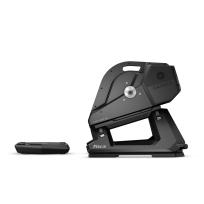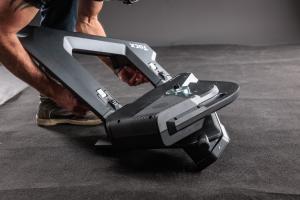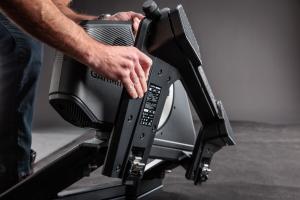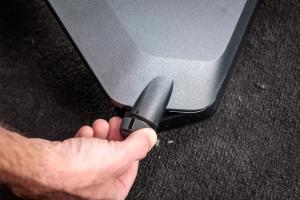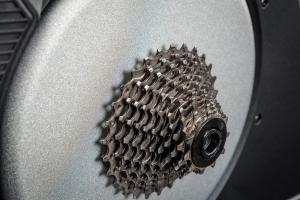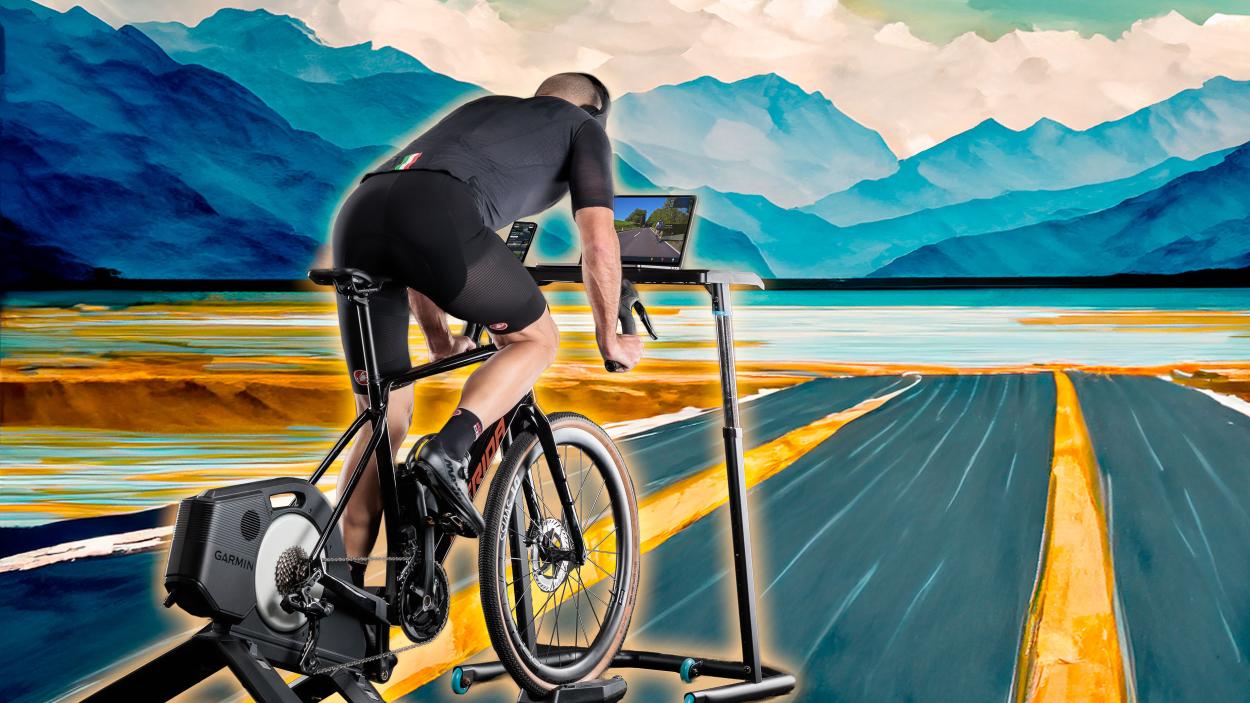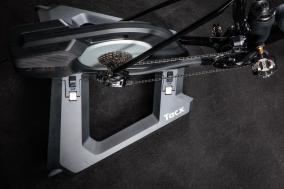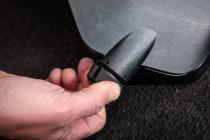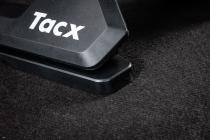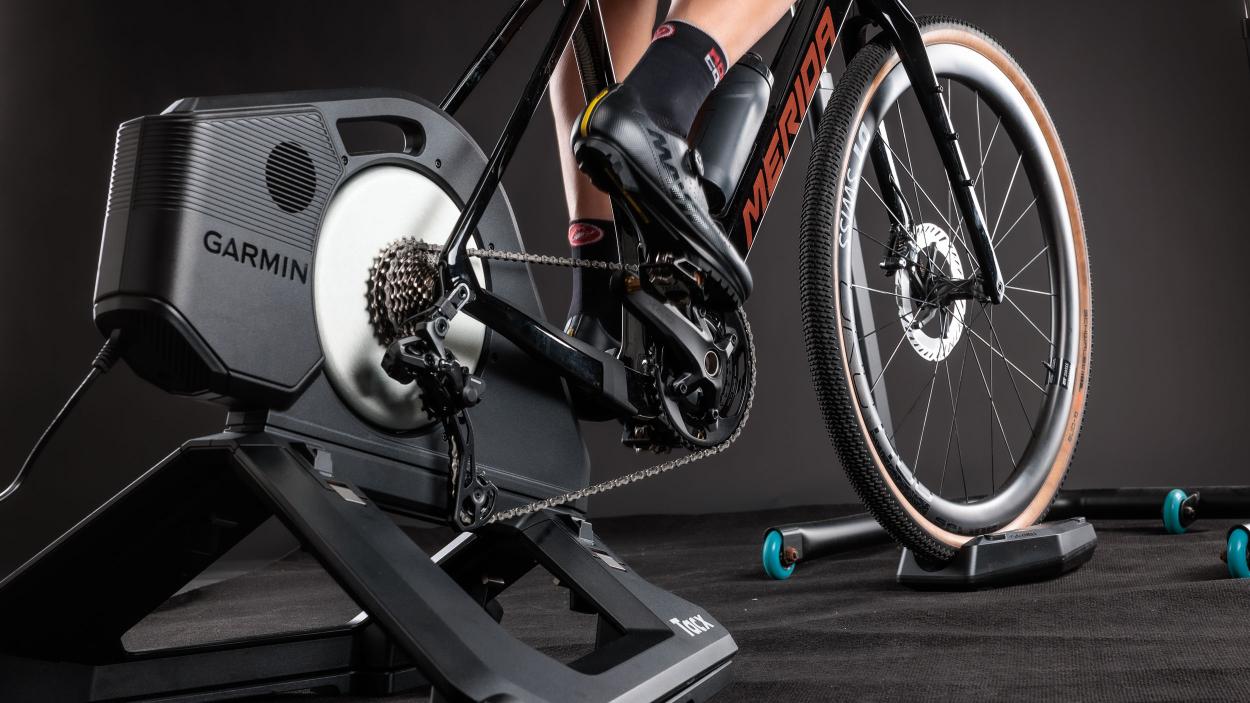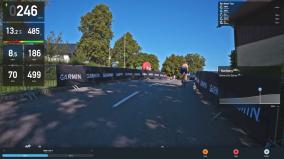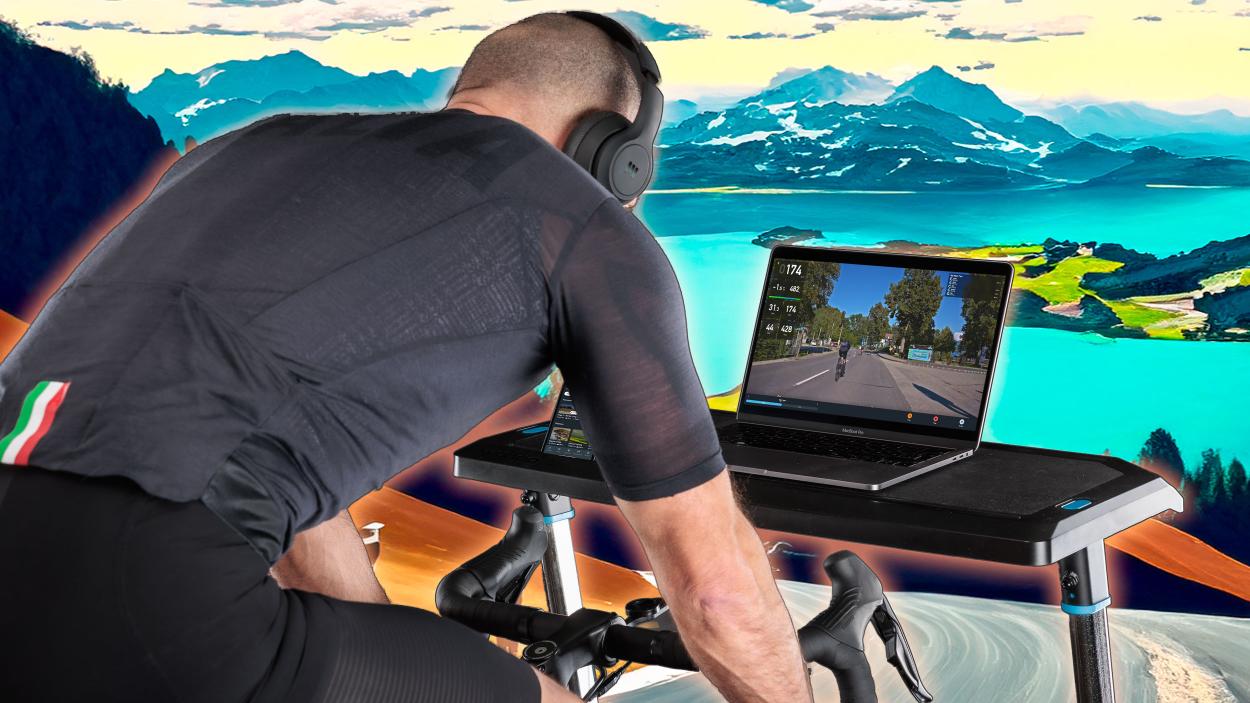
Garmin Tacx Neo 3M Review
19.02.24 07:45 1272024-02-19T07:45:00+01:00Text: NoPain (translated by AI)Photos: Erwin HaidenSmart Wars III: Intensive review of the long-awaited update to Garmin's Tacx Neo series and the new flagship in interstellar design. Featuring integrated motion plates, an improved resistance unit for low speeds on steep climbs, the ability to handle two parallel Bluetooth connections, as well as WiFi and Ethernet connectivity via optional accessories.19.02.24 07:45 3392024-02-19T07:45:00+01:00Garmin Tacx Neo 3M Review
19.02.24 07:45 3392024-02-19T07:45:00+01:00 NoPain (translated by AI) Erwin HaidenSmart Wars III: Intensive review of the long-awaited update to Garmin's Tacx Neo series and the new flagship in interstellar design. Featuring integrated motion plates, an improved resistance unit for low speeds on steep climbs, the ability to handle two parallel Bluetooth connections, as well as WiFi and Ethernet connectivity via optional accessories.19.02.24 07:45 3392024-02-19T07:45:00+01:00During the indoor training boom amidst the Corona pandemic, numerous manufacturers have significantly invested in the (further) development of their smart trainers. As a result, there are currently a multitude of options in the mid-price range. The functionality is impressive, the devices impress with innovative features, and the wattage performances are more than sufficient. Moreover, the prices have dropped, which doesn't exactly make the decision-making process easier. However, while most providers strive to outdo each other in terms of price-performance ratio, there is one manufacturer that particularly stands out with its new development.
"Nice price"? No way. Instead, the Garmin Tacx Neo 3M probably offers one of the best, if not the best performance on the current smart trainer market. The heart of the 1,999.99 Euro premium trainer is still its brake unit, consisting of a magnetic motor brake with 32 neodymium magnets and a virtual flywheel. Together, they not only generate a maximum resistance of 2,200 watts but can also simulate six different road surfaces and descents in an especially realistic way. Added to this are the new movement feature and some other technical refinements.
Be sure to keep reading to find out if the Garmin Tacx Neo 3M fits your athlete profile and is worth the money.
Nice price"? No way.
Instead: Premium Performance!
Design (Changes from the Neo 2T)
After four years of waiting, Garmin presents the Tacx Neo 3M. It follows the futuristic design of its predecessor, and the drive technology has essentially remained the same, yet it sets new visual standards. "Heavier, longer, wider, taller, and more sophisticated" - this could summarize its visual appearance. But these attributes alone do not do justice to the smart trainer, because above all, it is one thing: powerful.
Although the total weight has only increased by 2.1 kilograms despite the integrated Motion Plates, and the base area has only become minimally longer and wider, the volume of the trainer body has significantly increased. This is probably because the power adapter is now integrated into the movable housing, the cooling has been optimized, and the smart trainer has received a generous carrying handle. According to Garmin, these changes were necessary to increase accuracy at low cadence/high power and low power/high cadence. Nevertheless, the officially stated accuracy of <1% remains unchanged, which is why the targeted improvements are lost in the data sheet jungle without further explanation.
Despite the enormous dimensions of the brake unit, which tend to make it more difficult to insert the training wheel, compatibility with disc brakes - especially with short chainstays - has been improved. Another small detail on the side: With its top model, Garmin has completely omitted the light blue contrasting color, giving the trainer an even more sophisticated look.
Tacx Neo Generations Review
| Neo 3M | Neo 2T (T2875) | |
| Watt Accuracy* | +/- 1% | +/- 1% |
| Resistance | Electromagnetic, 32 neodymium magnets | |
| Max. Resistance | 2,200 Watts | 2,200 Watts |
| Max. Torque | 88 Nm | 88 Nm |
| Max. Incline | 25% | 25% |
| ERG Mode | Yes | Yes |
| Downhill Simulation | Yes | Yes |
| Road Surface Simulation | Yes | Yes |
| Flywheel | Virtual | Virtual |
| Electrical Connection | 100 to 240V AC, also works autonomously without power source | |
| Lateral Movement | Yes, minimal | Yes, minimal |
| Forward/Backward Movement Function | Yes (25 mm forward, 25 mm backward) | No |
| Movement Lock | Yes | No |
| Incline Simulation | Yes, with Elite Rizer (Neo 3M only with activated movement lock) | |
| Freewheel Compatibility | Shimano 9-12 speed and Sram 10-11 speed | |
| Cassette Included** | Yes (Shimano/Sram 11-speed) | |
| Suitable Axles*** | Quick release (130 mm/135 mm x 5 mm), Thru-axles (142 mm/148 mm x 12 mm) | |
| Connectivity | ANT+ FE-C, Bluetooth LE (2 channels), WLAN/LAN**** | ANT+ FE-C, Bluetooth LE |
| Control | Smartphone, Tablet, ANT+ Bike Computer, autonomous, Computer connection via ANT+ Antenna | |
| Connection Indicator | Multicoloured LED | 2 LEDs |
| Performance Indicator | Multicoloured LED, Spotlight on the floor | |
| Data Collection | Speed, Cadence, Power | |
| Race Mode | No (to be implemented) | no |
| Dimensions (LxWxH) | 630 x 800 x 595 mm | 575 x 750 x 550 mm |
| Weight | 23.6 kg | 21.5 kg |
| Scope of Delivery | Trainer with pre-installed cassette, Front wheel support (compatible with up to 60 mm wide tires), Power cable, Quick release and various adapters, Voucher code for Tacx Premium Software | |
| Price | € 1,999.99 | € 1,299.00 |
* Auto-calibration
** Bundles with additional cassettes (SRAM XD/XDR, Shimano Micro Spline, Campa) available
*** For 135-mm thru-axles, Garmin offers this adapter set as additional accessory: 10 x 135 on the non-drive side, 12 x 135 on the non-drive side and 10 x 135 on the drive side
**** WLAN and Ethernet connectivity with optional Tacx Smart Network Adapter
More elegant, more precise, more transmissible,
optionally glides forwards and backwards and above all: more expensive.
Unboxing and Setup
Despite the increase in weight and size, the Neo is easier to take out of the box than before. You grab the trainer by the carrying handle, lift it out with a strong "heave-ho," and set it down. For assembly, you then unfold the legs, making sure that the mechanism locks into place completely, which is indicated by a blue signal color. With the two twist locks on the back, you can lock or unlock the Motion Plates.
Inside the box, you will also find the manual, the power cord, a bunch of adapters, a free three-month Tacx Premium subscription, and the front wheel block. With a pre-installed Shimano 11-speed cassette and a self-explanatory installation process via the Tacx Training App, Garmin promises immediate riding pleasure. If you own a 12-speed groupset but only do structured workouts in ERG mode, you will still find a suitable gear with the 11-speed cassette. However, for training or racing in SIM mode, we strongly recommend switching to a corresponding 12-speed cassette.
We have documented the installation and configuration process for you in photographs.
In the next step, the appropriate adapters for the rear dropout of the training bike need to be screwed into the trainer. The Garmin manual assists with identification, and the included blue tool can be used for screwing them in. If necessary, however, this can also be done by hand or with any standard tool. The end caps for the thru-axle or the quick release are inserted.
Now, only the power cable needs to be connected to the back of the case, and the trainer is ready to use. The design of the device is intended to ensure a stable position even during intense training sessions. There is no height adjustment for the wheel size and it is not necessary or possible to align the legs to the ground. The integrated carry handle also helps with storing the 23.6 kg heavy trainer after the indoor session.
Due to the wider housing design, some restrictions may occur when mounting the bike. Therefore, we recommend shifting to a smaller cog or, if possible, even to the smallest cog at the rear so that the derailleur does not rub against the edge of the housing or bump into the legs of the Neo. The longer the cage, the more difficult the task. In fact, there is only about one millimeter of space between the derailleur cage and the round metallic "flywheel" at the largest cog, so the derailleur hanger should also be meticulously aligned.
Before we start with the training, we still need to place the included front wheel block under the front tire, which supports forward and backward movement. This is a double-sided design, which is made for racing bike tires on one side and for tires up to 61 millimeters on the other. Note: be sure to observe the direction of the arrow and position the front wheel axle exactly above the marking.
To connect, we pair the Neo 3M with the smartphone, install the latest firmware updates via the Tacx Training App, and configure the few necessary settings according to our preferences. To have the Tacx Neo 3M displayed on the smartphone or in the Tacx Training App, the new pairing button on the trainer must be pressed beforehand. Otherwise, this button has no further use. A second Bluetooth channel has been added, which can be useful when the ride data is being recorded on two devices at the same time or when a companion app is connected during the training.
If there are problems with Bluetooth or ANT+ connections or if multiple trainers are to be operated in one room, there is the possibility to establish a stable WLAN/LAN connection with the optionally available Tacx Smart network adapter. It is odd that no WLAN module is included as standard given the high purchase price, but that cannot be changed. The WLAN/LAN connection is available for an additional cost of 149.99 euros.
Tacx Training App Photo Gallery
Generally, four operating states are possible
- Plugged in and connected: With external power supply and connected training app, all functions are available.
- Standalone: If no app and no Edge bike computer are connected, the trainer simulates a flat road and uses the standard settings for air and road resistance as well as for user and bike weight.
- No external power supply: In autonomous operation, the trainer does not support a downhill mode and only offers a limited riding experience. Button presses or Ethernet or Wi-Fi communication with the Tacx Smart Network Adapter do not work either.
- Standby: When the Tacx NEO 3M is not in use, it switches to standby mode after five minutes. Without external power supply, this happens after just 10 seconds.
Zero point zero zero point calibrations needed.
Garmin Tacx Neo 3MIn the practical test
The Neo 3M, while based on the electromagnetic technology of the Neo 2T and still offering a maximum resistance power of 2,200 Watts at a max incline of 25%, has seen improvements in measurement accuracy, even though the official specification in the datasheet remains unchanged at <1%. Especially in extreme training situations such as low cadence at high power (on inclinations) or high cadence at low power (on descents), the values should now be more precise.
However, the descent simulation, the optional "Road Feel" of the road surface simulation, and the light show, which is projected under the Tacx trainer with a Multicolour LED, remain unchanged. Here, the color blue stands for low, violet for medium, and red for high power output.
The two training modes ERG & SIM have also remained the same, which have especially gained popularity in the virtual worlds of Rouvy, Zwift & Co.
ERG mode: Setting a specific power level - e.g., 200 Watts. During rides or workouts, the predetermined training resistance remains constant and even, regardless of the chosen gear ratio, pedaling frequency, and virtual topography. Pedal, sweat, done.
SIM mode: Simulation of a given topography (inclines and declines) as outdoors - e.g., 10% incline. In this mode, it is necessary to choose the gear ratio according to the desired resistance or to work on the pedaling frequency, as the training resistance is not fixed but only the angle of incline. When riding virtual routes and races, shifting is constant, which is why the cassette must match the derailleur and be meticulously adjusted.
The Neo 3M braking unit continues to operate without belts, thus eliminating a source of noise and a critical wear part. In addition to the resulting quiet operation, another nice feature is that because the motor brake works similarly to a dynamo and generates electricity while riding, the new Tacx operates without an external power supply.
M for Motion
Newly added are the integrated Motion Plates, a mechanism for forward and backward movement of the trainer body. This was available as an option for earlier Neo models and was attached underneath the supports to allow for 2.5 cm of movement both forward and backward. Apart from the twist knob on the back of the two supports, both the design and functionality largely remained unchanged. However, the front wheel block was updated to also accommodate wider MTB or gravel tires.
Despite this, the Neo 3M offers an even more realistic riding feel than the Neo 2T with Motion Plates. This is primarily due to the improved lateral freedom of movement, which allows the bicycle to move left and right independently of the Motion Plates. Overall, the training while seated and with a consistent pedaling motion standing up comes very close to outdoor riding, as the many small movements that occur through subtle shifting of body weight reduce the pressure on the saddle and decrease fatigue during longer workouts.
While we wouldn't want to do without the lateral freedom of movement anymore, the forward/backward movement is not optimal in all situations. For example, during sprints, one repeatedly hits the front and rear stops, and the transition from a seated to a standing position does not always work smoothly. However, over time, one develops a feel for it and can significantly minimize drastic weight shifts.
As with the KICKR MOVE, we find it difficult to give a clear recommendation for the integrated Motion Plates, as their actual benefit lies more in longer rides than in wild all-out sprints. In our opinion, many endurance riders will appreciate the increased comfort, while HIT athletes will tend to deactivate the feature.
Nevertheless, even hardcore trainers with deep pockets can confidently opt for the Tacx Neo 3M, because once the lock is activated, they have a fully functional, quiet, stiff smart trainer with the option to enjoy the recovery ride after the race weekend even more.
A more realistic and enjoyable riding experience, if one can afford it.
Garmin Tacx Neo 3M with integrated Motion PlatesAccuracy
As already mentioned, Garmin promises a power accuracy of plus or minus 1%, similar to its predecessor, the Neo 2T. However, the Neo 3M was developed and equipped with improved cooling to offer higher accuracy across a wider range of power levels, especially for extremely high wattage resistance at low cadences and vice versa. Numerous test rides on Rouvy, where a Shimano Dura-Ace power meter was also used in parallel, confirmed the reliability of the power data.
Our standard protocol also showed a close match with the Shimano Dura-Ace power meter, with only minimal deviations noted. Note: The calibration process of the trainer is automatic, making manual calibration unnecessary. The Dura-Ace power meter, on the other hand, was manually calibrated using Shimano eTube software.
Comparison Neo 3M vs. Shimano PM
| Tacx Neo 3M (Watt) | Shimano PM (Watt Avg) | Shimano PM Offset (Watt) | Shimano PM Offset (%) | Shimano PM TF (RPM) | |
|---|---|---|---|---|---|
| Zero point | Auto-zero | Calibration | - | - | - |
| Warm-up 10 min | 100 Watt | 96 Watt | -4 Watt | -4.0% | 79 RPM |
| Warm-up 10 min | 150 Watt | 148 Watt | -2 Watt | -1.3% | 74 RPM |
| Zero point | Auto-zero | Auto-zero | - | - | - |
| 5 min, seated | 150 Watt | 147 Watt | -3 Watt | -2.0% | 77 RPM |
| 5 min, seated | 170 Watt | 169 Watt | -1 Watt | -0.6% | 73 RPM |
| 5 min, seated | 190 Watt | 187 Watt | -3 Watt | -1.6% | 71 RPM |
| 5 min, seated | 210 Watt | 207 Watt | -3 Watt | -1.4% | 74 RPM |
| 5 min, seated | 230 Watt | 226 Watt | -4 Watt | -1.4% | 59 RPM |
| 5 min, seated | 250 Watt | 248 Watt | -2 Watt | -0.8% | 64 RPM |
| 1 min, standing | 300 Watt | 299 Watt | -1 Watt | -0.3% | 55 RPM |
| Total | 157 Watt | 154 Watt | -3 Watt | -1.3% | 70 RPM |
Even DCR considers this trainer to be one of the most accurate he has ever reviewed, if not the most accurate. He could find virtually no flaws regarding power accuracy in both simulation and ERG modes, or any temperature fluctuations, which he was able to prove through numerous comparative tests.
The Tacx Neo 3M shines not only in simulations in SIM mode but also during intervals in ERG mode. No matter how abrupt the power jump is, the Neo 3M smoothly transitions the rider into the interval, adjusts the resistance quickly, and glides just as smoothly out. Even with too strong a pedaling force and exceeding the resistance, the Neo 3M gently, yet precisely, pulls the rider back. This entire process takes about four seconds.
Tacx Training App & ASVÖ King of the Lake
In combination with the Tacx Training App, for which a three-month premium subscription is included with the purchase of the Tacx Neo 3M, Garmin's virtual worlds are opened up.
The Tacx Training App offers a comprehensive selection of training programs for cyclists at all levels, including the ability to ride real routes and complete virtual rides. This way, you can choose from a variety of routes around the world and enhance your training experience with realistic simulations of inclines, declines, and other terrain features.
ASVÖ KING OF THE LAKE 2023
Newly added is the route of the "ASVÖ King of the Lake 2023", which was recorded on September 16, 2023, during the unique individual and team time trial around Lake Attersee in Europe.
Battles for seconds, new records, burning legs, and overjoyed faces - compete against the clock at any time and measure yourself virtually with 1,400 cyclists from 26 nations.
Furthermore, the Tacx Training App offers an intuitive user interface that makes it easy to plan, perform, and analyze training. With detailed performance data and analysis tools, you can track your progress and optimize your training strategy.
Conclusion (and comparison with the KICKR MOVE)
| Garmin Tacx Neo 3M | |
|---|---|
| Model Year: | 2023/24 |
| Price: | € 1,999.99 |
| + | More realistic riding experience |
| + | Top resistance performance |
| + | Highest accuracy |
| + | Quiet and low vibration |
| + | Descent simulation |
| + | Terrain simulation |
| + | Quick setup |
| + | Design (incl. carrying handle) |
| + | Power-LED feature |
| + | Lateral freedom of movement |
| o | Only 5 cm of movement freedom forwards and backwards |
| o | Huge dimensions |
| - | No WiFi/LAN as standard |
| - | €400 more expensive than the Wahoo KICKR Move |
| BB-Verdict: | The Starship among smart trainers. |
Just like Wahoo's KICKR MOVE, Garmin's Tacx Neo 3M Smarttrainer offers a successful compromise between space requirements and realistic riding experience compared to bulky rocker plates. However, it should be noted that the subtle forward, backward, and lateral movements feel incredibly natural, but occur at a lower level than with the KICKR MOVE. However, this can also have advantages, as the rider does not have to fight against excessive tilting or rocking movements during intense sessions or when out of the saddle, while still benefiting from the higher seating comfort.
In direct comparison to Wahoo's KICKR MOVE (incl. Wi-Fi, easier wheel installation, Climb compatibility, and Race mode), the Tacx Neo 3M is €400 (or with Tacx Smart Network adapter €550) more expensive. In return, Garmin's premium smart trainer boasts an even more modern design, features like descent or road surface simulation, a laser light show reminiscent of earlier P1 times, and unmatched accuracy. Besides, we are not aware of any other home device that implements power settings as perfectly during the most intense ERG intervals.
For those who can afford it, the Tacx Neo 3M Smarttrainer is an excellent choice and will undoubtedly provide long-lasting enjoyment. Those who can do without the integrated motion plates, the second parallel Bluetooth channel, the optional WLAN/LAN module, and the improved climbing features at ultra-low cadences will still do well with the Tacx Neo 2T (T2875) and save a whole €700. Both Tacx Neo smart trainers respond precisely to power changes, possess features for terrain and descent simulation, and don't let you hit the proverbial wall even with larger watt jumps. In terms of accuracy and zero-point calibration, they are among the best devices on the market. Moreover, they are extremely quiet - as long as the 3M is locked, the only audible sounds come from the drivetrain and the bike's derailleur.














